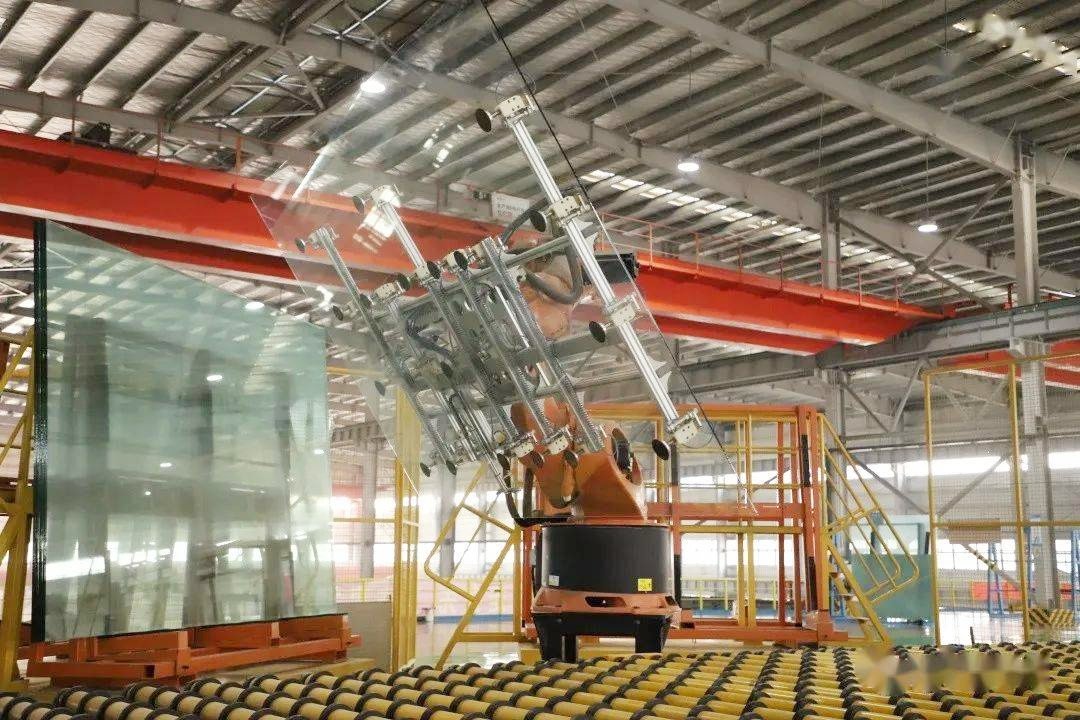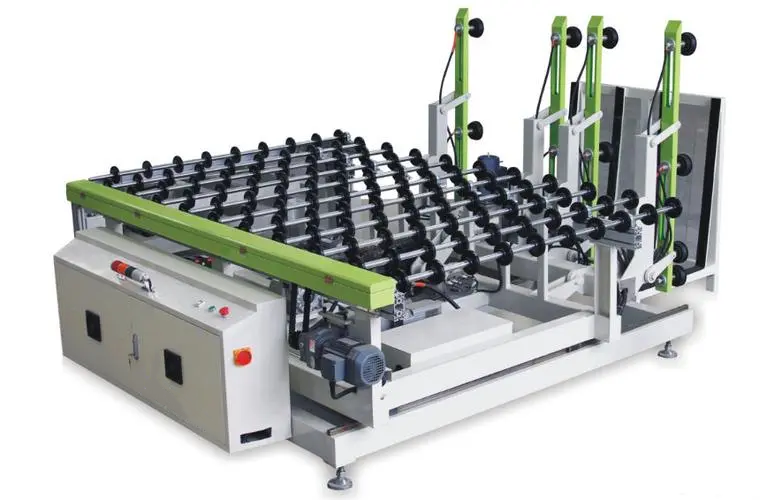Cold-end equipment of large-tonnage ultra-clear float glass production line.
1. The preface
In the ultra-clear float glass production line, the cold-end equipment is a very important production link, which means that the glass is produced from the annealing kiln and enters the cold-end equipment for inspection, cutting, edge removal, and other processes, and is further processed into glass products. After passing the inspection, it arrives at the picking area for packing. The scale of large-tonnage ultra-clear float glass production lines is generally above 1,000 tons per day. The current glass original plate is more than 5 meters wide, so the requirements for cold-end equipment are high, and it must be able to cut and break large and small pieces of glass original plate and multiple pieces. The sorting and conveying requirements for cold-end equipment are higher. Cold-end equipment usually includes testing equipment, cutting systems, conveying spokes, stacking devices, etc.

Figure 1 The stacking devices of cold-end equipment ultra-clear float glass production line
2. The ultra clear float glass
Glass is a commonly used material in the construction industry and can be produced in a variety of ways. Among them, ultra-clear float glass is a common variety and a new type of float glass. It is flat glass produced by ultra-clear float glass technology. It has a high visible light transmittance, which is less than ordinary float glass The content of ferric oxide is limited, and its content is generally below 0.015%. When the thickness of ultra-clear float glass is less than 3 mm, the visible light transmittance can be increased to more than 90%, so the appearance of ultra-clear float glass looks crystal clear. Compared with ordinary float glass, ultra-clear float glass has better optical, mechanical, and physical properties, and is generally used in high-end building decoration, high-end furniture, and thin-film solar cells. Due to the high added value and high-grade quality of ultra-clear float glass, it has attracted more attention from the industry. Ultra-clear float glass adopts the same production process as ordinary float glass, but the visible light transmission of its products is relatively high, and there are differences in raw materials, process characteristics, and material materials. Ultra-clear float glass requires extremely high iron content. The content of ferric oxide in the commonly used siliceous raw materials cannot exceed 0.006%. At the same time, the content of refractory heavy minerals is strictly controlled, and there are also extremely high requirements for the content of iron in dolomite and aluminum hydroxide.
3. Common cold-end equipment of large-tonnage ultra-clear float glass production line
3.1 The testing equipment
(1) Defect detection system.
To detect defects in glass products, use a camera to take photos of the products, and use a computer system to analyze the photos to determine whether there are defects. After the inspection is completed, use the marking system to evaluate the grade of the glass product.At the same time, the detected defects are sent to the cutting system, and the computer system is used to optimize the cutting of the glass again. Compared with manual inspection, it can improve the accuracy of inspection, reduce missed inspection and false inspections, and avoid the restriction and influence of human factors. At the same time, it can communicate with the control system PLC to realize the linkage control of the cutting machinee.
(2) Stress meter.
The stress curve can be drawn. The principle is that after the glass product is irradiated with a polarized beam, the photoelectric sensor is used to convert it into an electrical signal, which is analyzed and processed by the computer system. After analyzing the stress curve generated by the stress meter, the process parameters of the annealing kiln Make timely adjustments to make the product achieve the best annealing. The strain gauge can be installed at the front end of the cold-end unit, which can effectively guide the annealing of glass products, increase the yield of glass, and make up for the error of traditional annealing temperature adjustment based on manual experience.
(3) Side thickness meter.
It can detect the thickness of the glass ribbon, and detect the thickness of the glass according to the light reflection by irradiating the glass with light, which helps adjust the process parameters of the shutter. The accuracy of the thickness gauge can reach more than 0.02 mm.
3.2 The cutting and braking system
After the glass ribbon comes out of the lehr, the glass needs to be cut and broken to form a glass plate. The system includes cutting equipment, edge-breaking equipment, etc.
(1) Cutting equipment, including slitting machines, cross-cutting machines, etc.
Among them, the cutting area detection bridge can detect broken boards and board edges. Because in the production process, the glass ribbon may break, and it must be adjusted in time. Unknown deflection of the glass ribbon may occur during production, so the position of the broken edge must be monitored. Cutting and edge breaking are performed based on the detected data. In addition, it is also equipped with a length-measuring and sending device, which can measure the length of the glass ribbon. Cut the glass to a specified length with a cross-cutting machineThe slitting machine is installed upstream and downstream of the beam, and can work simultaneously or alternately. The purpose of the slitting machine is to ensure that the running direction of the glass is parallel to the longitudinal cut mark, and it is adjusted by the slitting machine when the deviation of the glass ribbon occurs. It is mainly completed through the cooperation of the cutter wheel and the spare cutter wheel. Cross-cutting machine: Use the cylinder to drive the cutter wheel to work, when the glass ribbon has obvious deviation. The cross-cutting machine can start tracking and control the length direction error of the glass plate by adjusting the positions of the falling and lifting points of the knife.Sending system: the glass belt is pressed by a certain weight wheel, and the small wheel of the photoelectric encoder is driven by the big wheel, which can improve measurement accuracy.Horizontal breaking device: After the glass ribbon has been cut transversely, it can be broken along the generated scratches by the horizontal breaking device, so that the glass ribbon can be formed into a glass plate. It is mainly controlled by the air cylinder. Generally, the glass ribbon with a thickness of about 25 mm can be broken by the horizontal breaking device.
(2) Edge-breaking device, including edge-breaking radial channel and edge-holding device, etc.
It can be linked with the slitting machine to track the deviation of the glass ribbon. Including the floor car, the pair of spokes, the edge head, and so on. The ground car is on the fixed frame of the floor and consists of 4 trolleys. Every two trolleys on the left and right sides of the centerline form a group and always keep synchronous movement. The width of the spoke track is adjusted according to the width of the original glass plate for inserting the spoke. The edge-breaking head can perform a second edge-breaking. The first edge breaking is driven by the cylinder to knock off the edge of the glass, and the second edge breaking uses the radiation pressure method to increase the edge pressure and then break off the excess part. The edge-holding device can enlarge the slit of longitudinal cutting and improve the quality of edge breaking. Usually, when the thickness of the glass is thicker, the cut marks produced by the slitting machine are shallow, which may lead to uneven edge breaking and waste products. Therefore, the edge-pressing device is used to enlarge the cut marks and improve the quality of edge breaking.
(3) Split vertically. Longitudinal splitting is used for panel width division.
After the slitting knife cuts out a certain size, the longitudinal splitting moves to a specific position. When the glass passes through the vertical top, the vertical top lifts and separates the glass along the knife marks. But the glass has not been cut, the distance between the two pieces of glass is relatively close, and the distance between the two pieces of glass can be increased after the longitudinal division uses four splays to form an angle.
4. The conveying and picking the device
Including conveying spokes, fragmentation steering equipment, falling board crushing devices, etc. The conveying spokes can distance the broken glass plates to avoid collisions and reduce the incidence of edge bursts and sub-plates.
(1) Falling board crushing device.
The system for detecting and disposing of glass plates. The unqualified glass is processed through the glass breaking system, which can break multiple pieces of glass or glass of unequal width using a new keyboard drop plate and a 4-piece combined drop plate.
(2) Fragment steering device. The finished glass sheets can be transported smoothly and safely, and the conveyor can be used for slicing.

Figure 2 The shard steering device equipment
(3) Stacker.
The stacking system has independent PLC control, which can pack glass products into boxes. The stacker includes a boom, a pulling trolley, and a rotating carrier. The glass is conveyed to the stacker, and the big arm of the stacker moves downward, and when it touches the glass piece, the suction cup is used to hold the glass big arm and lift it. There are two types of stackers: vertical and horizontal. Horizontal stacking is easy to operate, low in cost, and easy to maintain. However, every time the sheet is taken out, the board must be stopped, and the stacking cycle is long, which may damage or scratch the glass. Vertical stacking can reduce scratches and damages, and the cycle of changing stacks is short. It is generally used in the stacking of small and medium-sized pieces of glass.
5. The auxiliary equipment duster.
The powder spraying machine can spray the anti-mildew powder on the glass products. Because if the glass is not used for a long time and the isolation layer is not used, the original glass plate will be mildewed and damaged. Spraying anti-mildew powder with a duster can protect glass products from damage and is a very economical and practical surface protection device for glass products.
For more information about LIJIANG Glass insulated glass production line and insulated glass producing machine, please click here to learn more.


